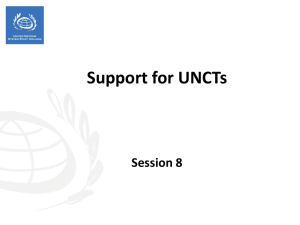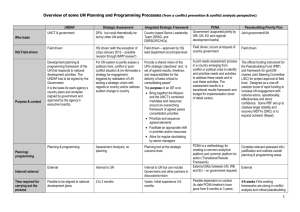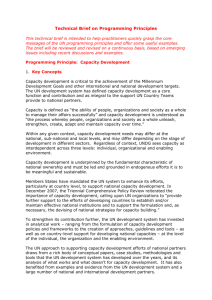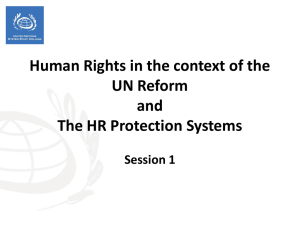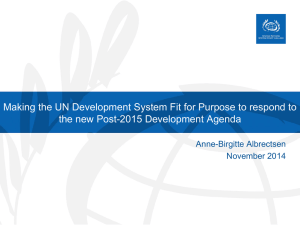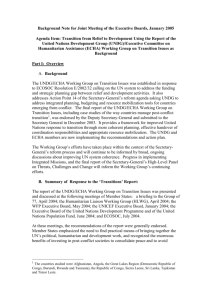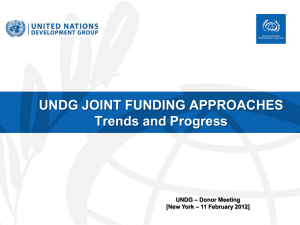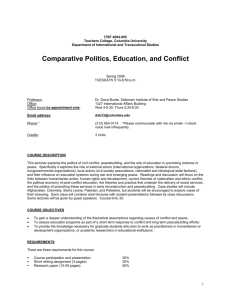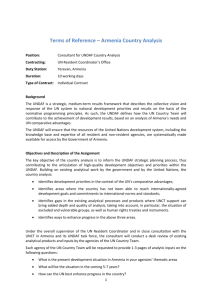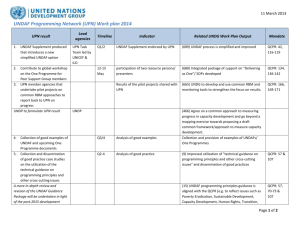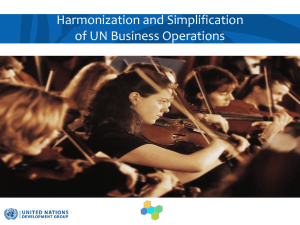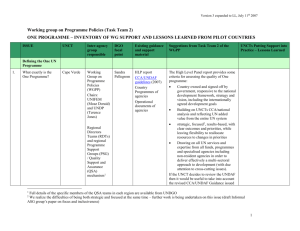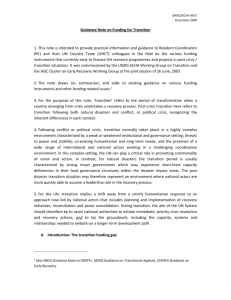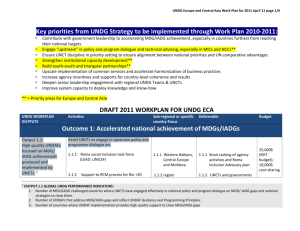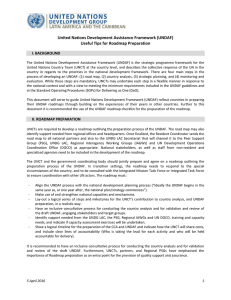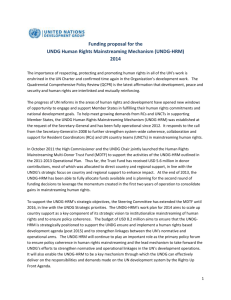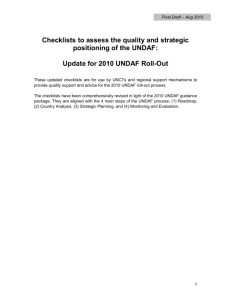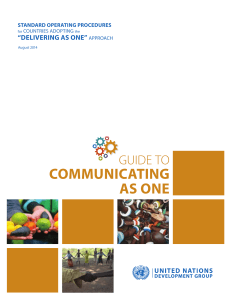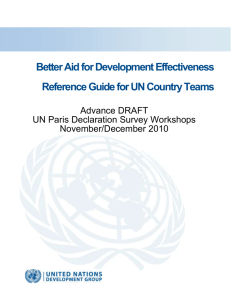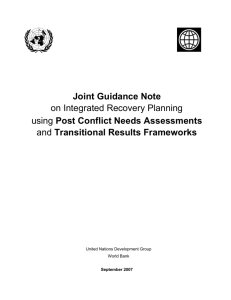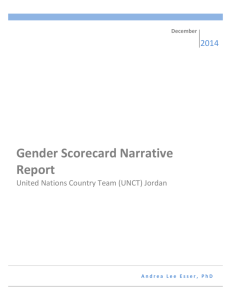Guidance Note on Funding for Transition
advertisement
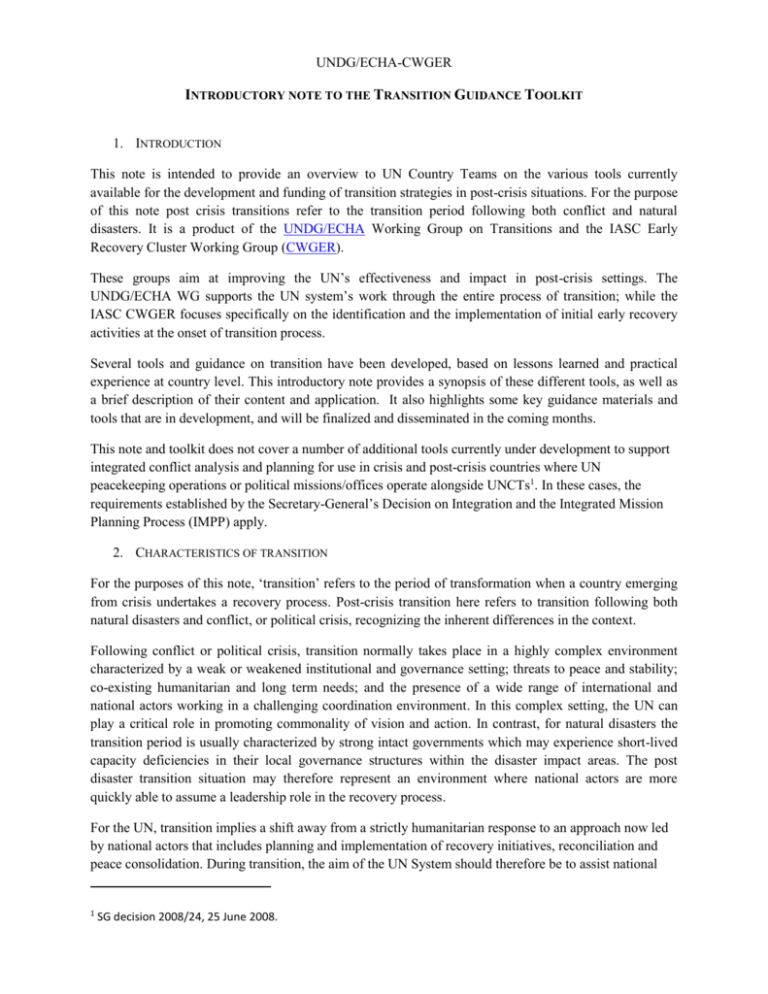
UNDG/ECHA-CWGER INTRODUCTORY NOTE TO THE TRANSITION GUIDANCE TOOLKIT 1. INTRODUCTION This note is intended to provide an overview to UN Country Teams on the various tools currently available for the development and funding of transition strategies in post-crisis situations. For the purpose of this note post crisis transitions refer to the transition period following both conflict and natural disasters. It is a product of the UNDG/ECHA Working Group on Transitions and the IASC Early Recovery Cluster Working Group (CWGER). These groups aim at improving the UN’s effectiveness and impact in post-crisis settings. The UNDG/ECHA WG supports the UN system’s work through the entire process of transition; while the IASC CWGER focuses specifically on the identification and the implementation of initial early recovery activities at the onset of transition process. Several tools and guidance on transition have been developed, based on lessons learned and practical experience at country level. This introductory note provides a synopsis of these different tools, as well as a brief description of their content and application. It also highlights some key guidance materials and tools that are in development, and will be finalized and disseminated in the coming months. This note and toolkit does not cover a number of additional tools currently under development to support integrated conflict analysis and planning for use in crisis and post-crisis countries where UN peacekeeping operations or political missions/offices operate alongside UNCTs1. In these cases, the requirements established by the Secretary-General’s Decision on Integration and the Integrated Mission Planning Process (IMPP) apply. 2. CHARACTERISTICS OF TRANSITION For the purposes of this note, ‘transition’ refers to the period of transformation when a country emerging from crisis undertakes a recovery process. Post-crisis transition here refers to transition following both natural disasters and conflict, or political crisis, recognizing the inherent differences in the context. Following conflict or political crisis, transition normally takes place in a highly complex environment characterized by a weak or weakened institutional and governance setting; threats to peace and stability; co-existing humanitarian and long term needs; and the presence of a wide range of international and national actors working in a challenging coordination environment. In this complex setting, the UN can play a critical role in promoting commonality of vision and action. In contrast, for natural disasters the transition period is usually characterized by strong intact governments which may experience short-lived capacity deficiencies in their local governance structures within the disaster impact areas. The post disaster transition situation may therefore represent an environment where national actors are more quickly able to assume a leadership role in the recovery process. For the UN, transition implies a shift away from a strictly humanitarian response to an approach now led by national actors that includes planning and implementation of recovery initiatives, reconciliation and peace consolidation. During transition, the aim of the UN System should therefore be to assist national 1 SG decision 2008/24, 25 June 2008. DRAFT - Transition Guidance Note - DRAFT authorities to initiate immediate, priority crisis resolution and recovery actions, and to lay the groundwork, including the capacity, systems and relationships needed to embark on a longer-term development path. The graph below shows the different phases of the process from relief to development: Early recovery is an essential component in the process of the transition period from relief to development, when a country and communities re-establish themselves after a crisis. The UN and other actors’ contribution to early recovery begin while humanitarian activities are ongoing. In this context, early recovery is designed to help create a life-sustaining environment and to lay essential foundations for full recovery and a return to longer-term development. 3. CONTENT OF THE TRANSITION GUIDANCE TOOLKIT The Transition Guidance Toolkit has been developed by the UNDG/ECHA Working Group, and the CWGER. Its purpose is to provide guidance to UNCTs and partners in transition countries and includes tools, lessons learned and methodologies for the main building blocks of a UN response to post-crisis 2 DRAFT - Transition Guidance Note - DRAFT challenges, from strategic planning, to assessment/analysis to programming and funding. As such, the Transition Guidance Toolkit includes the following elements: 4.1 Planning for transition 4.1.1 Processes Post-Conflict Needs Assessments (PCNA): The Post-Conflict Needs Assessment (PCNA) is a methodology to map the needs of a country emerging from crisis or conflict and define a set of priorities and their financial implications. The PCNA provides a common analytical platform to align the activities of different actors and stakeholders in order to provide coherent support to a country in transition. National actors such as elected officials, public servants and civil society representatives lead this process. The assessment results in a Transitional Results Framework (TRF) which is the plan of action consolidated and costing the identified priorities. The value of the PCNA methodology comes not only from its substantive analysis and prioritization, but also from the assessment process, which can help participants to build consensus, to build ownership of priorities that are focused on the future, and to move towards peace and reconciliation. The PCNA/TRF tool kit is a compilation of guidance, reviews, lessons learned and good practices aimed at informing on the process and products of the PCNA. Post Disaster Needs Assessment and Recovery Framework (PDNA): The primary objective of the PDNA is to facilitate the recovery from a disaster to the goals of the development process. The PDNA provides a framework for an integrated, synergic assessment of disaster impacts involving two perspectives: (i) the valuation of physical damages and economic losses; and, (ii) the identification of human recovery needs. It takes into account the overlapping phases in disaster, the integration of gender issues, national capacity enhancement, international response coordination, linkage to national development goals and how when and why to apply the PDNA. Common Country Assessment/United Nations Development Assistance Framework (CCA/UNDAF): The CCA is the joint UN assessment and analysis of a country. The UNDAF is the strategic programme framework for the UNCT. Based on the CCA, the UNDAF describes the collective response of the UNCT to the MD/MDG related priorities in the national development framework. The CCA/UNDAF focuses in the areas where the UNCT can make the biggest difference; the process attempts to address root causes of the challenges identified in the assessment. The new CCA/UNDAF guidelines respond to the need for more flexibility to conduct country analysis and to develop the strategic programming framework in transition settings. The guidelines focus on the roadmap, country analysis, strategic planning and monitoring and evaluation. The guidelines are complemented by a technical guidance with detailed information on process and tools. 3 DRAFT - Transition Guidance Note - DRAFT In countries where the development of a CCA/UNDAF would be impossible, for example where no government is in place, UNCTs may develop a Transition Strategy. This is an unofficial term used to refer to the UN’s strategic response in the aftermath of a conflict or disaster-related crisis. The term “transition strategy” should be understood to encompass UN objectives variously related to early recovery, reconstruction, peace-building and peace consolidation. The Guidance Note on Transition Strategy is designed to provide guidance on the overall framework and process for developing strategic plans during the transition phase. It outlines the key principles and components of the strategic planning process, such as the needs assessment, conflict assessment, and funding options. Building on the revised CCA/UNDAF guidelines, the note emphasizes the characteristics of planning in transition, and focuses on the elements of strategic positioning to guide UNCTs in determining how it can best contribute to a country’s transition needs. Strategic Assessment (SA): The Strategic Assessment provides a mechanism for joint analysis and strategic discussions that cut across the political, security, development, humanitarian and human rights aspects of the UN’s work. It brings together the key UN departments and agencies in each of these areas and is intended to allow senior decision-makers, in particular the Secretary-General, to consider new or re-oriented forms of UN engagement based on the country’s needs. It builds upon existing department and agency analysis and assessment processes as well as relevant outside research. The SA is an assessment process, not a planning one. Its focus is strategic rather than operational. The purpose of the Strategic Assessment Guidelines2 is to outline a process for UN staff to conduct an inter-departmental and inter-agency Strategic Assessment of a political crisis, conflict or post-conflict situation. IMPP (Integrated Strategic Framework): UNCT and multi-dimensional peacekeeping operations or political/missions/offices working in the same transition setting should have a shared vision of the UN’s strategic objectives and a set of agreed results, timelines, and responsibilities for the delivery of tasks critical to consolidating peace. The ISF is the process through which the UN presence in a country achieves this. The IMPP Guidelines: Role for the Field3 describe the process and advice on integrated field coordination and shared analytical and planning capacities. These guidelines complement the IMPP Guidelines which give advice on integrated strategy and planning from a HQ perspective (link).. Implementing Early Recovery: Early recovery addresses a critical gap in coverage between humanitarian relief and long-term recovery—between reliance and self-sufficiency. While working within a humanitarian setting, early recovery team workers have their eyes on the future—assessing damages to 2 For more information on these guidelines please contact the focal point for integration in DOCO (http://www.undg.org/docs/10575/DOCO's-Who's-Who_December-2009_for-UNDG-website.pdf) 3 Ibid. 4 DRAFT - Transition Guidance Note - DRAFT infrastructure, property, livelihoods, and societies. Their goal is to enable a smoother transition to longterm recovery—to restore livelihoods, government capacities, shelter—and offer hope to those who survived the crisis. The Guidance Note on Early Recovery, developed by the Cluster Working Group on Early Recovery (CWGER), provides step by step guidance on how to identify, plan, implement and monitor opportunities for recovery during the humanitarian phase and onward into the longer-term transition period. In addition to explaining how to establish and maintain Early Recovery Clusters and Networks and access support from the global CWGER, it sets some basic guiding principles and minimum standards for intervention; provides a range of tools and further resources that may be of use to practitioners; and set the stage for an effective evolution into longer-term recovery processes. 4.1.2 Tools Conflict Analysis: The revised PCNA guidelines, as well as the new CCA/UNDAF guidelines, place renewed emphasis on conflict analysis and the need to assess needs and potential responses through conflict sensitive lenses. Such emphasis must follow through to the planning and the implementation phase of the UN response. Therefore, in order to ensure that UN programmes are based on a common contextual analysis of the key elements of peace building, a Conflict Analysis Framework has been developed under the guidance of the UNDG/ECHA Working Group. The Conflict Analysis Framework offers a methodology designed to guide the UNCT in its analysis of key conflict factors, essential actors and existing or potential capacities for peace. It is not a standalone tool but should be comprehensively applied as a lens through which to design the UNCT transition strategy. The analysis should be followed by a mapping of ongoing responses and an assessment of the impact of those responses, in order to identify gaps and needs for strengthening the conflict sensitivity of on-going interventions. Conflict Analysis and Prioritization: The objective of this tool is to assist planners use the results of conflict analysis within a transition setting to ensure that planning –including prioritization- and programming emanate from the conflict analysis, are conflict sensitive and can be monitored. Although part of the PCNA/TRF Tool Kit the conflict analysis and prioritization tool can be applied to any planning process. Framework for Durable Solutions for Internally Displace Persons: In 2004, a guidance note was developed on this issue, providing UNCTs which identify population displacement (refugees, internally displaced persons (IDPs) and/or returnees) as a key challenge facing the country and which seek to include strategic policies and programmes, in line with the national priorities, into the UNDAF and its results-based matrix. More recently, at the request of the UN Office for the Coordination of Humanitarian Affairs (OCHA), the Representative of the UN Secretary-General on Internally Displaced Persons (RSG) began the process of developing a set of benchmarks to provide guidance on determining when an individual should no longer be considered to be in need of protection and assistance as an internally displaced person. The RSG, in cooperation with the Brookings-Bern Project on Internal Displacement and Georgetown University’s Institute for the Study of International Migration, later joined by the Internal Displacement Monitoring Centre of the Norwegian Refugee Council, hosted three meetings to gain the input of international organizations, governments, nongovernmental organizations and experts on internal displacement. The organizers also commissioned case studies that were published in a special issue of 5 DRAFT - Transition Guidance Note - DRAFT Forced Migration Review. The project is being completed under the guidance of the current RSG, Walter Kalin4. In the IASC WG meeting of March 2007, it was decided that this document should be considered a framework and was welcomed as such by the IASC WG. 5 4.2 Funding for transition The above-mentioned elements concentrate on the planning phase of the transition. Once the planning process concluded, the funding question is raised. However, ensuring sustained funding flows during the transition from relief to development remains a largely unresolved challenge and constitutes one of the main characteristics of the transition ‘gap’. Despite compelling evidence of the linkages between risk reduction and development, it is still much easier to mobilize support for relief efforts than for recovery activities. Against this background, the Transitional guidance Toolkit also compiles guidance and description of the different funding instruments which have been developed that can be used to fund early recovery and longer term recovery activities (including the traditional humanitarian funding instruments namely: Flash Appeals, Consoildated Appeals, Central Emergency Response Fund, Common Humanitarian Pooled Funds and Emergency Response Funds).The three main recovery/development oriented instruments namely: Multi-donor Trust Funds, Transitional Appeals and the Peace Building Fund are described briefly below: Multi-Donor Trust Funds (MDTFs): A number of MDTFs have recently been established in post conflict settings. MDTFs are sometimes mandated by peace agreements or are established as a product of a PCNA process. In response, the UN system has strengthened its capacity to participate in and manage such pooled funding mechanisms through the creation or strengthening of dedicated expertise within the agencies. At the inter-agency level, systems and procedures, including standard agreements, have been established to reduce both transaction costs and the time required for the UN to establish an MDTF in which agencies can participate and channel resources to transition activities. The UNDG has developed guidance on how MDTFs are structured, and how the UNCT can participate in them. Transitional Appeals: in some cases, UNCTs have used the appeal mechanism by expanding its scope to include funding for (early) recovery activities. Experience to date shows that success hinges on the extent to which the Appeal reflects and is based on a solid strategic approach and the level of engagement with government and donors from the outset. Building on lessons learned, the UNDG has also developed specific guidance on how to incorporate recovery activities in appeals, in addition to and beyond their traditional humanitarian focus. 4 For meeting reports, see www.brookings.edu/fp/projects/conferences/contents.htm. As an update to these developments, UNDP in collaboration with the RSG’s office, UNHCR and OCHA, co-organized a workshop to look at the application of this framework within early recovery contexts. The workshop led to the revision of the framework to take into account new opportunities created by early recovery and the specific challenges faced by IDPs affected by natural disasters. This revision process is being co-led by the RSG’s Office, UNDP and UNHCR, and is expected to be completed by the end of 2009. 5 6 DRAFT - Transition Guidance Note - DRAFT The Peacebuilding Fund (PBF): in recognition of the time lag often needed to develop more sustained funding mechanisms for transition processes, the international community agreed to establish a Peacebuilding Fund within the new peacebuilding architecture at the UN. The PBF is designed to address immediate peacebuilding needs in countries emerging from conflict at a time when other funding mechanisms are not available. The Fund is managed by the UN peacebuilding support office (PBSO) and administered by UNDP. As such, UN agencies can access resources meant to provide catalytic support until longer term instruments are put in place. Countries can have access to PBF resources either by being referred by the Peacebuilding Commission or at the discretion of the Secretary General. In addition, the PBF has recently opened an emergency window whereby the UN presence on the ground, can request immediate support for specific peacebuilding projects. All these mechanisms are often designed to supplement, and not replace established bilateral channels between UN agencies and donors. In fact, even in situations where pooled funds have been established, donors need to be reminded that agency-specific funds (reserve and/or emergency funds) are often still appropriate to jump start activities that may then be supported through other sources. Therefore, a UNCT strategy for transition can be funded through a combination of those mechanisms, including individual bilateral fundraising. For example, the appeal can either be the costed strategy or a costed section of the strategy, if the UNCT chooses to use the appeal only for specific components and programmes of its transition strategy. Some components of the strategy may be better suited to an appeal while others may correspond to the focus of an MDTF, if one has been established, or funding from PBF. Therefore, a costed plan or strategy, for example a Transitional Resource Framework (TRF), should include information on existing funds and the balance for which support is being requested, at the disaggregated project level as well as the consolidated level. It is also important that financial requirements, and the structure under which they are presented, be in line with the costing of the national priorities, to ensure consistency and transparency. In addition to these transition specific funding instruments, depending on the specificities of the country and situation, it may be appropriate to include activities related to early recovery activities and transition activities in general, within financial instruments normally used for the emergency funding, such as flash appeals. 7
